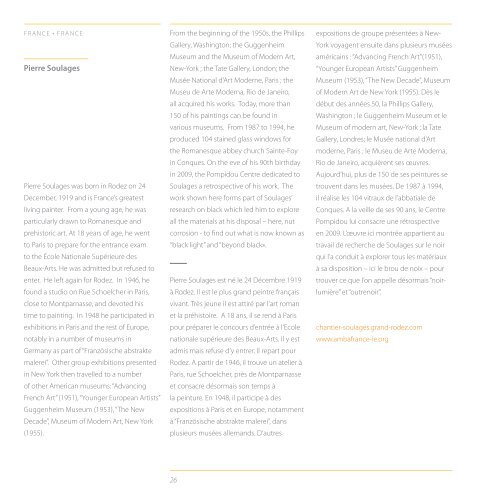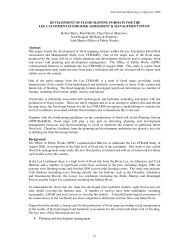Kaleidoscope Catalogue - Office of Public Works
Kaleidoscope Catalogue - Office of Public Works
Kaleidoscope Catalogue - Office of Public Works
Create successful ePaper yourself
Turn your PDF publications into a flip-book with our unique Google optimized e-Paper software.
FrAnce • FrAnce<br />
Pierre Soulages<br />
Pierre Soulages was born in Rodez on 24<br />
December, 1919 and is France’s greatest<br />
living painter. From a young age, he was<br />
particularly drawn to Romanesque and<br />
prehistoric art. at 18 years <strong>of</strong> age, he went<br />
to Paris to prepare for the entrance exam<br />
to the École nationale Supérieure des<br />
Beaux-arts. He was admitted but refused to<br />
enter. He left again for Rodez. In 1946, he<br />
found a studio on Rue Schoelcher in Paris,<br />
close to Montparnasse, and devoted his<br />
time to painting. In 1948 he participated in<br />
exhibitions in Paris and the rest <strong>of</strong> europe,<br />
notably in a number <strong>of</strong> museums in<br />
germany as part <strong>of</strong> “Französische abstrakte<br />
malerei”. Other group exhibitions presented<br />
in new york then travelled to a number<br />
<strong>of</strong> other american museums: “advancing<br />
French art” (1951), “younger european artists”<br />
Guggenheim Museum (1953), “The new<br />
Decade”, Museum <strong>of</strong> Modern art, new york<br />
(1955).<br />
From the beginning <strong>of</strong> the 1950s, the phillips<br />
Gallery, Washington; the Guggenheim<br />
Museum and the Museum <strong>of</strong> Modern art,<br />
new-york ; the Tate Gallery, London; the<br />
Musée national d’art Moderne, Paris ; the<br />
Museu de arte Moderna, Rio de Janeiro,<br />
all acquired his works. Today, more than<br />
150 <strong>of</strong> his paintings can be found in<br />
various museums. From 1987 to 1994, he<br />
produced 104 stained glass windows for<br />
the Romanesque abbey church Sainte-Foy<br />
in Conques. On the eve <strong>of</strong> his 90th birthday<br />
in 2009, the Pompidou Centre dedicated to<br />
Soulages a retrospective <strong>of</strong> his work. The<br />
work shown here forms part <strong>of</strong> Soulages’<br />
research on black which led him to explore<br />
all the materials at his disposal – here, nut<br />
corrosion - to find out what is now known as<br />
“black light” and “beyond black».<br />
Pierre Soulages est né le 24 Décembre 1919<br />
à Rodez. Il est le plus grand peintre français<br />
vivant. Très jeune il est attiré par l’art roman<br />
et la préhistoire. a 18 ans, il se rend à Paris<br />
pour préparer le concours d’entrée à l’ecole<br />
nationale supérieure des Beaux-arts. Il y est<br />
admis mais refuse d’y entrer. Il repart pour<br />
Rodez. a partir de 1946, il trouve un atelier à<br />
Paris, rue Schoelcher, près de Montparnasse<br />
et consacre désormais son temps à<br />
la peinture. en 1948, il participe à des<br />
expositions à Paris et en europe, notamment<br />
à “Französische abstrakte malerei”, dans<br />
plusieurs musées allemands. D’autres<br />
26<br />
expositions de groupe présentées à newyork<br />
voyagent ensuite dans plusieurs musées<br />
américains : “Advancing French Art”(1951),<br />
“younger european artists” Guggenheim<br />
Museum (1953), “The new Decade”, Museum<br />
<strong>of</strong> Modern art de new york (1955). Dès le<br />
début des années 50, la Phillips Gallery,<br />
Washington ; le Guggenheim Museum et le<br />
Museum <strong>of</strong> modern art, new-york ; la Tate<br />
Gallery, Londres; le Musée national d’art<br />
moderne, Paris ; le Museu de arte Moderna,<br />
Rio de Janeiro, acquièrent ses œuvres.<br />
aujourd’hui, plus de 150 de ses peintures se<br />
trouvent dans les musées. De 1987 à 1994,<br />
il réalise les 104 vitraux de l’abbatiale de<br />
Conques. a la veille de ses 90 ans, le Centre<br />
Pompidou lui consacre une rétrospective<br />
en 2009. L’œuvre ici montrée appartient au<br />
travail de recherche de Soulages sur le noir<br />
qui l’a conduit à explorer tous les matériaux<br />
à sa disposition – ici le brou de noix – pour<br />
trouver ce que l’on appelle désormais “noirlumière”<br />
et “outrenoir”.<br />
chantier-soulages.grand-rodez.com<br />
www.ambafrance-ie.org

















